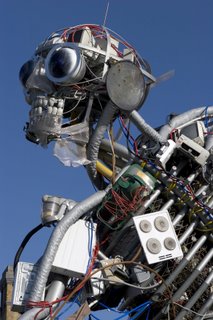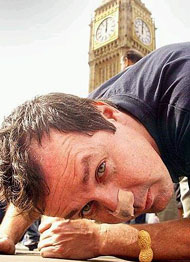
So mostly this posting is about catching up on things I have been wanting to comment on. (And I am waiting for the Friday craigslist to populate itself with the apartment listings for the weekend).
First up, Activism v. Art v. Stunts. I have for some time now been curious about the blurry lines between art that is political in nature and politics that are artistic in nature. This may seem a curious statement, but here's what I mean. Many artists want to address political issues in their work, creating 'artwork' that come off more as 'stunts,' the work is more interesting in its political content than in its artistic content.
Let me say right now that this is an issue that I contemplate quite a lot. I do think it is important to make some kind of impact with your artwork (otherwise why bother to put it in public view). This impact could be purely emotional or have a more cognitive impact.

So here are some of the artists I am thinking about (pulled from this article on Green Futures): Mark McGowan turned on a tap at a gallery to demonstrate water waste, and pushed a peanut around with his nose to protest student loan debt; Michael Landy's destruction of all of his belongings: WEEE man in London, the giant sculpture made of technological refuse; and Banksy, who's clever street art is stunningly well executed.
I like all of these works and artists, but I have some questions and comments regarding the works. I am struck by Landy and Banksy's work on an artistic level. McGowan and WEEE man strike me as terribly clever stunts that bring awareness to issues, but not necessarily art. Of course as soon as I say that I start to waiver. So here are the questions:
What makes political art successful as Art (yeh with a capital a)?
What makes political art successful as activist project? (Do any of these works *really* make people rethink their habits?)

So here are some answers I have formulated. I definitely believe that for political art to be successful it has to have more than the "moment effect." I am making up this new term to describe the kind of artwork that you look at and immediately 'get it' and then there is no more to the work. It is work that is really easy to understand what it is addressing. Its the kind of thing that Kuspit in 'The End of Art' describes as a lack of translation. Artists taking information readily available in the news and recontextualizing it as art without translating it using their own creative voice.
In response to the second question, I don't think these works have any long term affect. Yeh people got mad about McGowan running water in the gallery, and the Water company threatened to shut off water to the gallery. But I doubt the people involved in getting it shut down really than changed their habits (taking less and/or shorter showers, conserving water while washing dishes).
So how then can artwork achieve both of these issues? I think it is important to do one of two things, either create artwork that involves the public in its process, thereby teaching them something *in the process* of creating the work. Or (and this is far more difficult) create works that are so powerful emotionally that they affect the viewers on a very very deep level.

So now you want to know, okay who has done this? Well I don't have a lot of contemporary artists, but as the Green Future Article points out, there's Joseph Beuys' 7000 Oaks project. Much of Beuys' work was political or social commentary that was presented in an emotionally powerful way, the Oaks project was a very direct hands on project which involved the community. Another work which I constantly rely on (I should try to find some others) is Picasso's Guernica. It is an extremely powerful work which emotionally affects the viewers. (And that's reinforced by the need of the US Govt to request the painting be covered).
Bottom line, I don't have it all figured out yet, but that's part of the process of art making right? I am still angry, so I am working on environmental action projects, some which involve the public, and some which I hope will have an emotional impact, so we will just have to see what comes of it all.
(Okay this post was longer than I had hoped, so the posts on remembering Exit Art's Garden of Sculptural Delights, and what is environmental art, will just have to wait)



1 comment:
I can't believe I wrote this whole thing and forgot to mention Simon Starling, winner of this year's Turner Prize. I wanted to mention that I consider his work to be very successful activist art (in my opinion) because the action makes a statement and then it culminates in an object. I think the sublime and solitary acts are beautiful in their own right, and the manifestation of the work in the gallery takes on a new and beautful force.
Post a Comment